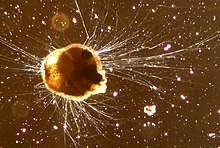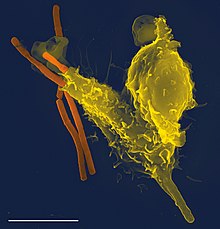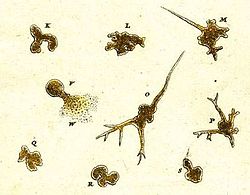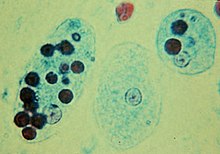Amoeba

Anamoeba(/əˈmiːbə/;less commonly spelledamebaoramœba;pl.:amoebas(less commonly,amebas) oramoebae(amebae)/əˈmiːbi/),[1]often called anamoeboid,is a type ofcellorunicellular organismwith the ability to alter its shape, primarily by extending and retractingpseudopods.[2]Amoebae do not form a singletaxonomic group;instead, they are found in every majorlineageofeukaryoticorganisms. Amoeboid cells occur not only among theprotozoa,but also infungi,algae,andanimals.[3][4][5][6][7]
Microbiologistsoften use the terms "amoeboid" and "amoeba" interchangeably for any organism that exhibitsamoeboid movement.[8][9]
In older classification systems, most amoebae were placed in theclassorsubphylumSarcodina, a grouping ofsingle-celled organismsthat possess pseudopods or move byprotoplasmicflow. However,molecular phylogeneticstudies have shown that Sarcodina is not amonophyleticgroup whose members sharecommon descent.Consequently, amoeboid organisms are no longer classified together in one group.[10]
The best known amoeboidprotistsareChaos carolinenseandAmoeba proteus,both of which have been widely cultivated and studied in classrooms and laboratories.[11][12]Other well known species include the so-called "brain-eating amoeba"Naegleria fowleri,the intestinal parasiteEntamoeba histolytica,which causesamoebic dysentery,and the multicellular "social amoeba" orslime mouldDictyostelium discoideum.
Shape, movement and nutrition
[edit]
Amoeba do not have cell walls, which allows for free movement. Amoeba move and feed by using pseudopods, which are bulges ofcytoplasmformed by the coordinated action ofactinmicrofilamentspushing out theplasma membranethat surrounds the cell.[13]The appearance and internal structure of pseudopods are used to distinguish groups of amoebae from one another.Amoebozoanspecies, such as those in the genusAmoeba,typically have bulbous (lobose) pseudopods, rounded at the ends and roughly tubular in cross-section.Cercozoanamoeboids, such asEuglyphaandGromia,have slender, thread-like (filose) pseudopods.Foraminiferaemit fine, branching pseudopods that merge with one another to form net-like (reticulose) structures. Some groups, such as theRadiolariaandHeliozoa,have stiff, needle-like, radiatingaxopodia(actinopoda) supported from within by bundles ofmicrotubules.[3][14]
Free-living amoebae may be "testate"(enclosed within a hard shell), or" naked "(also known asgymnamoebae,lacking any hard covering). The shells of testate amoebae may be composed of various substances, includingcalcium,silica,chitin,or agglutinations of found materials like small grains of sand and thefrustulesofdiatoms.[15]
To regulateosmotic pressure,most freshwater amoebae have a contractilevacuolewhich expels excess water from the cell.[16]Thisorganelleis necessary because freshwater has a lower concentration ofsolutes(such as salt) than the amoeba's own internal fluids (cytosol). Because the surrounding water ishypotonicwith respect to the contents of the cell, water is transferred across the amoeba's cell membrane byosmosis.Without a contractile vacuole, the cell would fill with excess water and, eventually, burst. Marine amoebae do not usually possess a contractile vacuole because the concentration of solutes within the cell are in balance with thetonicityof the surrounding water.[17]
Diet
[edit]
The food sources of amoebae vary. Some amoebae are predatory and live by consuming bacteria and otherprotists.Some aredetritivoresand eat dead organic material.
Amoebae typically ingest their food byphagocytosis,extending pseudopods to encircle and engulf live prey or particles of scavenged material. Amoeboid cells do not have a mouth orcytostome,and there is no fixed place on the cell at which phagocytosis normally occurs.[18]
Some amoebae also feed bypinocytosis,imbibing dissolved nutrients throughvesiclesformed within the cell membrane.[19]
Size range
[edit]
The size of amoeboid cells and species is extremely variable. The marine amoeboidMassisteria voersiis just 2.3 to 3micrometresin diameter,[20]within the size range of many bacteria.[21]At the other extreme, the shells of deep-seaxenophyophorescan attain 20 cm in diameter.[22]Most of the free-living freshwater amoebae commonly found inpond water,ditches, and lakes aremicroscopic,but some species, such as the so-called "giant amoebae"Pelomyxa palustrisandChaos carolinense,can be large enough to see with the naked eye.
| Species or cell type | Size in micrometers |
|---|---|
| Massisteria voersi[20] | 2.3–3 |
| Naegleria fowleri[23] | 8–15 |
| Neutrophil(white blood cell)[24] | 12–15 |
| Acanthamoeba[25] | 12–40 |
| Entamoeba histolytica[26] | 15–60 |
| Arcella vulgaris[27] | 30–152 |
| Amoeba proteus[28] | 220–760 |
| Chaos carolinense[29] | 700–2000 |
| Pelomyxa palustris[30] | up to 5000 |
| Syringammina fragilissima[22] | up to200000 |
Amoebae as specialized cells and life cycle stages
[edit]
Somemulticellular organismshave amoeboid cells only in certain phases of life, or use amoeboid movements for specialized functions. In the immune system of humans and other animals, amoeboidwhite blood cellspursue invading organisms, such as bacteria and pathogenic protists, and engulf them byphagocytosis.[31]
Amoeboid stages also occur in the multicellular fungus-like protists, the so-calledslime moulds.Both the plasmodial slime moulds, currently classified in the classMyxogastria,and the cellular slime moulds of the groupsAcrasidaandDictyosteliida,live as amoebae during their feeding stage. The amoeboid cells of the former combine to form a giantmultinucleateorganism,[32]while the cells of the latter live separately until food runs out, at which time the amoebae aggregate to form a multicellular migrating "slug" which functions as a single organism.[8]
Other organisms may also present amoeboid cells during certain life-cycle stages, e.g., the gametes of some green algae (Zygnematophyceae)[33]and pennatediatoms,[34]the spores (or dispersal phases) of someMesomycetozoea,[35][36]and thesporoplasmstage ofMyxozoaand ofAscetosporea.[37]
Amoebae as taxa
[edit]Early history and origins of Sarcodina
[edit]

The earliest record of an amoeboid organism was produced in 1755 byAugust Johann Rösel von Rosenhof,who named his discovery "Der Kleine Proteus" ( "the Little Proteus" ).[38]Rösel's illustrations show an unidentifiable freshwater amoeba, similar in appearance to the common species now known asAmoeba proteus.[39]The term "Proteus animalcule" remained in use throughout the 18th and 19th centuries, as an informal name for any large, free-living amoeboid.[40]
In 1822, the genusAmiba(from theGreekἀμοιβήamoibe,meaning "change" ) was erected by the French naturalistBory de Saint-Vincent.[41][42]Bory's contemporary,C. G. Ehrenberg,adopted the genus in his own classification of microscopic creatures, but changed the spelling toAmoeba.[43]
In 1841,Félix Dujardincoined the term "sarcode"(from Greek σάρξsarx,"flesh," and εἶδοςeidos,"form" ) for the "thick, glutinous, homogeneous substance" which fills protozoan cell bodies.[44]Although the term originally referred to the protoplasm of any protozoan, it soon came to be used in a restricted sense to designate the gelatinous contents of amoeboid cells.[10]Thirty years later, the Austrian zoologistLudwig Karl Schmardaused "sarcode" as the conceptual basis for his division Sarcodea, aphylum-level group made up of "unstable, changeable" organisms with bodies largely composed of "sarcode".[45]Later workers, including the influential taxonomistOtto Bütschli,amended this group to create the class Sarcodina,[46]ataxonthat remained in wide use throughout most of the 20th century.
Within the traditional Sarcodina, amoebae were generally divided intomorphological categories,on the basis of the form and structure of theirpseudopods.Amoebae with pseudopods supported by regular arrays ofmicrotubules(such as the freshwaterHeliozoaand marineRadiolaria) were classified asActinopoda;whereas those with unsupported pseudopods were classified asRhizopoda.[47]The Rhizopods were further subdivided into lobose, filose, and reticulose amoebae, according to the morphology of their pseudopods.
Dismantling of Sarcodina
[edit]In the final decade of the 20th century, a series of molecular phylogenetic analyses confirmed that Sarcodina was not amonophyleticgroup. In view of these findings, the old scheme was abandoned and the amoebae of Sarcodina were dispersed among many other high-level taxonomic groups. Today, the majority of traditional sarcodines are placed in two eukaryotesupergroups:AmoebozoaandRhizaria.The rest have been distributed among theexcavates,opisthokonts,andstramenopiles.Some, like theCentrohelida,have yet to be placed in any supergroup.[10][48]
Classification
[edit]Recent classification places the various amoeboid genera in the following groups:
| Supergroups | Major groups and genera | Morphology |
|---|---|---|
| Amoebozoa |
| |
| Rhizaria |
| |
| Excavata |
| |
| Heterokonta |
|
|
| Alveolata |
| |
| Opisthokonta |
|
|
| Ungrouped/ unknown |
|
Some of the amoeboid groups cited (e.g., part ofchrysophytes,part ofxanthophytes,chlorarachniophytes) were not traditionally included in Sarcodina, being classified asalgaeorflagellatedprotozoa.
Pathogenic interactions with other organisms
[edit]
Some amoebae can infect other organismspathogenically,causing disease:[52][53][54][55]
- Entamoeba histolyticais the cause ofamoebiasis,or amoebic dysentery.
- Naegleria fowleri(the "brain-eating amoeba" ) is a fresh-water-native species that can be fatal to humans if introduced through the nose.
- Acanthamoebacan cause amoebickeratitisandencephalitisin humans.
- Balamuthia mandrillarisis the cause of (often fatal)granulomatous amoebic meningoencephalitis.
Amoeba have been found to harvest and grow the bacteria implicated inplague.[56]Amoebae can likewise play host to microscopic organisms that are pathogenic to people and help in spreading such microbes. Bacterial pathogens (for example,Legionella) can oppose absorption of food when devoured by amoebae.[57] The currently generally utilized and best-explored amoebae that host other organisms are Acanthamoeba castellanii and Dictyostelium discoideum.[58] Microorganisms that can overcome the defenses of one-celled organisms can shelter and multiply inside them, where they are shielded from unfriendly outside conditions by their hosts.
Meiosis
[edit]Recent evidence indicates that several Amoebozoa lineages undergomeiosis.
Orthologsof genes employed inmeiosisof sexualeukaryoteshave recently been identified in theAcanthamoebagenome.These genes includedSpo11,Mre11,Rad50,Rad51,Rad52,Mnd1,Dmc1,MshandMlh.[59]This finding suggests that the ‘'Acanthamoeba'’ are capable of some form of meiosis and may be able to undergo sexual reproduction.
The meiosis-specificrecombinase,Dmc1,is required for efficient meiotichomologous recombination,andDmc1is expressed inEntamoeba histolytica.[60]The purified Dmc1 fromE. histolyticaformspresynapticfilaments and catalysesATP-dependenthomologous DNA pairingand DNA strand exchange over at least several thousandbase pairs.[60]The DNA pairing and strand exchange reactions are enhanced by the eukaryotic meiosis-specific recombination accessory factor (heterodimer) Hop2-Mnd1.[60]These processes are central to meiotic recombination, suggesting thatE. histolyticaundergoes meiosis.[60]
Studies ofEntamoeba invadensfound that, during the conversion from thetetraploiduninucleate trophozoiteto the tetranucleate cyst,homologous recombinationis enhanced.[61]Expression of genes with functions related to the major steps of meiotic recombination also increase during encystations.[61]These findings inE. invadens,combined with evidence from studies ofE. histolyticaindicate the presence of meiosis in theEntamoeba.
Dictyostelium discoideumin the supergroupAmoebozoacan undergo mating andsexual reproductionincluding meiosis when food is scarce.[62][63]
Since the Amoebozoa diverged early from theeukaryoticfamily tree, these results suggest that meiosis was present early in eukaryotic evolution. Furthermore, these findings are consistent with the proposal of Lahr et al.[64]that the majority of amoeboid lineages are anciently sexual.
References
[edit]- ^"Amoeba"Archived22 November 2015 at theWayback Machineat Oxforddictionaries.com
- ^Singleton, Paul (2006).Dictionary of Microbiology and Molecular Biology, 3rd Edition, revised.Chichester, UK: John Wiley & Sons. pp.32.ISBN978-0-470-03545-0.
- ^abDavid J. Patterson."Amoebae: Protists Which Move and Feed Using Pseudopodia".Tree of Life web project.Archivedfrom the original on 15 June 2010.Retrieved21 September2009.
- ^"The Amoebae".The University of Edinburgh. Archived fromthe originalon 10 June 2009.
- ^Wim van Egmond."Sun animalcules and amoebas".Microscopy-UK.Archivedfrom the original on 4 November 2005.Retrieved23 October2005.
- ^Flor-Parra, Ignacio; Bernal, Manuel; Zhurinsky, Jacob; Daga, Rafael R. (17 December 2013)."Cell migration and division in amoeboid-like fission yeast".Biology Open.3(1): 108–115.doi:10.1242/bio.20136783.ISSN2046-6390.PMC3892166.PMID24357230.
- ^Friedl, P.; Borgmann, S.; Bröcker, E. B. (1 October 2001). "Amoeboid leukocyte crawling through extracellular matrix: lessons from the Dictyostelium paradigm of cell movement".Journal of Leukocyte Biology.70(4): 491–509.doi:10.1189/jlb.70.4.491.ISSN0741-5400.PMID11590185.S2CID28731650.
- ^abMarée, Athanasius FM; Hogeweg, Paulien (2001)."How amoeboids self-organize into a fruiting body: multicellular coordination in Dictyostelium discoideum".Proceedings of the National Academy of Sciences.98(7): 3879–3883.doi:10.1073/pnas.061535198.PMC31146.PMID11274408.
- ^Mackerras, M. J.; Ercole, Q. N. (1947). "Observations on the action of paludrine on malarial parasites".Transactions of the Royal Society of Tropical Medicine and Hygiene.41(3): 365–376.doi:10.1016/s0035-9203(47)90133-8.PMID18898714.
- ^abcJan Pawlowski:The twilight of Sarcodina: a molecular perspective on the polyphyletic origin of amoeboid protists.Protistology, Band 5, 2008, S. 281–302.(pdf, 570 kB)Archived14 June 2013 at theWayback Machine
- ^Tan; et al. (2005)."A simple mass culture of the amoeba Chaos carolinense: revisit"(PDF).Protistology.4:185–90.Archived(PDF)from the original on 29 September 2017.Retrieved28 September2017.
- ^"Relationship with Humans".Amoeba proteus.12 April 2013.Archivedfrom the original on 29 September 2017.Retrieved28 September2017.
- ^Alberts Eds.; et al. (2007).Molecular Biology of the Cell 5th Edition.New York: Garland Science. p. 1037.ISBN9780815341055.
- ^Margulis, Lynn(2009).Kingdoms and Domains.Academic Press. pp.206–7.ISBN978-0-12-373621-5.
- ^Ogden, C. G. (1980).An Atlas of Freshwater Testate Amoeba.Oxford, London, and Glasgow: Oxford University Press, for British Museum (Natural History). pp. 1–5.ISBN978-0198585022.
- ^Alberts Eds.; et al. (2007).Molecular Biology of the Cell 5th Edition.New York: Garland Science. p. 663.ISBN9780815341055.
- ^Kudo, Richard Roksabro. "Protozoology." Protozoology 4th Edit (1954). p. 83
- ^Thorp, James H. (2001). Ecology and Classification of North American Freshwater Invertebrates. San Diego: Academic. p. 71.ISBN0-12-690647-5.
- ^Jeon, Kwang W. (1973).Biology of Amoeba.New York: Academic Press. pp.100.ISBN9780123848505.
- ^abMylnikov, Alexander P.; Weber, Felix; Jürgens, Klaus; Wylezich, Claudia (1 August 2015). "Massisteria marina has a sister: Massisteria voersi sp. nov., a rare species isolated from coastal waters of the Baltic Sea".European Journal of Protistology.51(4): 299–310.doi:10.1016/j.ejop.2015.05.002.ISSN1618-0429.PMID26163290.
- ^"The Size, Shape, And Arrangement of Bacterial Cells".classes.midlandstech.edu.Archived fromthe originalon 9 August 2016.Retrieved21 August2016.
- ^abGooday, A. J.; Aranda da Silva, A.; Pawlowski, J. (1 December 2011). "Xenophyophores (Rhizaria, Foraminifera) from the Nazaré Canyon (Portuguese margin, NE Atlantic)".Deep-Sea Research Part II: Topical Studies in Oceanography.The Geology, Geochemistry, and Biology of Submarine Canyons West of Portugal.58(23–24): 2401–2419.Bibcode:2011DSRII..58.2401G.doi:10.1016/j.dsr2.2011.04.005.
- ^"Brain-Eating Amoeba (Naegleria Fowleri): Causes and Symptoms".Archivedfrom the original on 21 August 2016.Retrieved21 August2016.
- ^"Anatomy Atlases: Atlas of Microscopic Anatomy: Section 4: Blood".www.anatomyatlases.org.Archivedfrom the original on 19 August 2016.Retrieved21 August2016.
- ^"Acanthamoeba| Microworld ".www.arcella.nl.Archived fromthe originalon 18 August 2016.Retrieved21 August2016.
- ^"Microscopy ofEntamoeba histolytica".msu.edu.Archivedfrom the original on 5 October 2016.Retrieved21 August2016.
- ^"Arcella vulgaris| Microworld ".www.arcella.nl.Archivedfrom the original on 18 August 2016.Retrieved21 August2016.
- ^"Amoeba proteus| Microworld ".www.arcella.nl.Archivedfrom the original on 18 August 2016.Retrieved21 August2016.
- ^"Chaos| Microworld ".www.arcella.nl.Archivedfrom the original on 12 October 2016.Retrieved21 August2016.
- ^"Pelomyxa palustris| Microworld ".www.arcella.nl.Archivedfrom the original on 18 August 2016.Retrieved21 August2016.
- ^Friedl, Peter; Borgmann, Stefan; Eva-B, Bröcker (2001). "Amoeboid leukocyte crawling through extracellular matrix: lessons from the Dictyostelium paradigm of cell movement".Journal of Leukocyte Biology.70(4): 491–509.doi:10.1189/jlb.70.4.491.PMID11590185.S2CID28731650.
- ^Nakagaki; et al. (2000)."Intelligence: Maze-solving by an amoeboid organism".Nature.407(6803): 470.Bibcode:2000Natur.407..470N.doi:10.1038/35035159.PMID11028990.S2CID205009141.
- ^Wehr, John D. (2003).Freshwater Algae of North America.San Diego and London: Academic Press. pp.353.ISBN978-0-12-741550-5.
- ^"Algae World: diatom sex and life cycles".Algae World.Royal Botanic Garden Edinburgh.Archivedfrom the original on 23 September 2014.Retrieved1 March2015.
- ^Valle, L.G. (2014). "New species of Paramoebidium (trichomycetes, Mesomycetozoea) from the Mediterranean, with comments about the amoeboid cells in Amoebidiales".Mycologia.106(3): 481–90.doi:10.3852/13-153.PMID24895422.S2CID3383757.
- ^Taylor, J. W. & Berbee, M. L. (2014). Fungi from PCR to Genomics: The Spreading Revolution in Evolutionary Biology. In:Systematics and Evolution.Springer Berlin Heidelberg. p. 52,[1]Archived30 June 2015 at theWayback Machine
- ^Corliss, J. O. (1987)."Protistan phylogeny and eukaryogenesis".International Review of Cytology.100:319–370.doi:10.1016/S0074-7696(08)61703-9.ISBN9780080586373.PMID3549607.
- ^Rosenhof, R. (1755).Monatlich herausgegebene Insektenbelustigungen,vol. 3, p. 621,[2]Archived13 July 2015 at theWayback Machine.
- ^Jeon, Kwang W. (1973).Biology of Amoeba.New York: Academic Press. pp. 2–3,[3].ISBN9780123848505.
- ^McAlpine, Daniel (1881).Biological atlas: a guide to the practical study of plants and animals.Edinburgh and London: W. & A. K. Johnston. pp.17.
- ^Bory de Saint-Vincent, J. B. G. M. "Essai d'une classification des animaux microscopiques." Agasse, Paris (1826).p. 28
- ^McGrath, Kimberley; Blachford, Stacey, eds. (2001).Gale Encyclopedia of Science Vol. 1: Aardvark-Catalyst(2nd ed.). Gale Group.ISBN978-0-7876-4370-6.OCLC46337140.
- ^Ehrenberg, Christian Gottfried. Organisation, systematik und geographisches verhältniss der infusionsthierchen: Zwei vorträge, in der Akademie der wissenschaften zu Berlin gehalten in den jahren 1828 und 1830. Druckerei der Königlichen akademie der wissenschaften, 1832. p. 59
- ^Dujardin, Felix (1841).Histoire Naturelle des Zoophytes Infusoires.Paris: Librarie Encyclopedique de Roret. pp.26.
- ^Schmarda, Ludwig Karl (1871).Zoologie.W. Braumüller. pp.156.
- ^Bütschli, Otto (1882).Klassen und Ordnungen des Thier-Reichs I. Abteilung: Sarkodina und Sporozoa.Paleontologische Entwicklung der Rhisopoda von C. Scwager. p. 1.
- ^Calkins, Gary N. (1909).Protozoölogy.New York: Lea & Febiger. pp.38–40.
- ^Adl, Sina M.; et al. (2012)."The Revised Classification of Eukaryotes".Journal of Eukaryotic Microbiology.59(5): 429–93.doi:10.1111/j.1550-7408.2012.00644.x.PMC3483872.PMID23020233.
- ^abPark, J. S.; Simpson, A. G. B.; Brown, S.; Cho, B. C. (2009). "Ultrastructure and Molecular Phylogeny of two Heterolobosean Amoebae, Euplaesiobystra hypersalinica gen. Et sp. Nov. And Tulamoeba peronaphora gen. Et sp. Nov., Isolated from an Extremely Hypersaline Habitat".Protist.160(2): 265–283.doi:10.1016/j.protis.2008.10.002.PMID19121603.
- ^Ott, Donald W., Carla K. Oldham-Ott, Nataliya Rybalka, and Thomas Friedl. 2015. Xanthophyte, Eustigmatophyte, and Raphidophyte Algae. In: Wehr, J.D., Sheath, R.G., Kociolek, J.P. (Eds.)Freshwater Algae of North America: Ecology and Classification,2nd edition. Academic Press, Amsterdam, pp. 483–534,[4]Archived22 January 2017 at theWayback Machine.
- ^Patterson, D. J.; Simpson, A. G. B.; Rogerson, A. (2000). "Amoebae of uncertain affinities". In: Lee, J. J.; Leedale, G. F.; Bradbury, P.An Illustrated Guide to the Protozoa,2nd ed., Vol. 2, p. 804-827. Lawrence, Kansas: Society of Protozoologists/Allen Press.[5]Archived8 March 2016 at theWayback Machine.Genera considered ungrouped/unknown by this source in 2000 but which have since become classified have been moved to those classifications on Wikipedia.
- ^Casadevall A (2008) Evolution of intracellular pathogens. Annu Rev Microbiol 62: 19–33. 10.1146/annurev.micro.61.080706.093305 [PubMed] [CrossRef] [Google Scholar]
- ^Guimaraes AJ, Gomes KX, Cortines JR, Peralta JM, Peralta RHS (2016) Acanthamoeba spp. as a universal host for pathogenic microorganisms: One bridge from environment to host virulence. Microbiological Research 193: 30–38. 10.1016/j.micres.2016.08.001 [PubMed] [CrossRef] [Google Scholar]
- ^Hilbi H, Weber SS, Ragaz C, Nyfeler Y, Urwyler S (2007) Environmental predators as models for bacterial pathogenesis. Environmental microbiology 9: 563–575. 10.1111/j.1462-2920.2007.01238.x [PubMed] [CrossRef] [Google Scholar]
- ^Greub, G; Raoult, D (2004)."Microorganisms resistant to free-living amoebae".Clinical Microbiology Reviews.17(2): 413–433.doi:10.1128/CMR.17.2.413-433.2004.PMC387402.PMID15084508.
- ^"Are amoebae safe harbors for plague? New research shows that plague bacteria not only survive, but thrive and replicate once ingested by an amoeba".
- ^Vidyasagar, Aparna (April 2016)."What Is an Amoeba?".livescience.com.Retrieved8 November2020.
- ^Thewes, Sascha; Soldati, Thierry; Eichinger, Ludwig (2019)."Editorial: Amoebae as Host Models to Study the Interaction with Pathogens".Frontiers in Cellular and Infection Microbiology.9:47.doi:10.3389/fcimb.2019.00047.PMC6433779.PMID30941316.
- ^Khan NA, Siddiqui R (2015)."Is there evidence of sexual reproduction (meiosis) in Acanthamoeba?".Pathog Glob Health.109(4): 193–5.doi:10.1179/2047773215Y.0000000009.PMC4530557.PMID25800982.
- ^abcdKelso AA, Say AF, Sharma D, Ledford LL, Turchick A, Saski CA, King AV, Attaway CC, Temesvari LA, Sehorn MG (2015)."Entamoeba histolytica Dmc1 Catalyzes Homologous DNA Pairing and Strand Exchange That Is Stimulated by Calcium and Hop2-Mnd1".PLOS ONE.10(9): e0139399.Bibcode:2015PLoSO..1039399K.doi:10.1371/journal.pone.0139399.PMC4589404.PMID26422142.
- ^abSingh N, Bhattacharya A, Bhattacharya S (2013)."Homologous recombination occurs in Entamoeba and is enhanced during growth stress and stage conversion".PLOS ONE.8(9): e74465.Bibcode:2013PLoSO...874465S.doi:10.1371/journal.pone.0074465.PMC3787063.PMID24098652.
- ^Flowers JM, Li SI, Stathos A, Saxer G, Ostrowski EA, Queller DC, Strassmann JE, Purugganan MD (2010)."Variation, sex, and social cooperation: molecular population genetics of the social amoeba Dictyostelium discoideum".PLOS Genet.6(7): e1001013.doi:10.1371/journal.pgen.1001013.PMC2895654.PMID20617172.
- ^O'Day DH, Keszei A (2012). "Signalling and sex in the social amoebozoans".Biol Rev Camb Philos Soc.87(2): 313–29.doi:10.1111/j.1469-185X.2011.00200.x.PMID21929567.S2CID205599638.
- ^Lahr DJ, Parfrey LW, Mitchell EA, Katz LA, Lara E (2011)."The chastity of amoebae: re-evaluating evidence for sex in amoeboid organisms".Proc. Biol. Sci.278(1715): 2081–90.doi:10.1098/rspb.2011.0289.PMC3107637.PMID21429931.
Further reading
[edit]- Walochnik, J. & Aspöck, H. (2007).Amöben: Paradebeispiele für Probleme der Phylogenetik, Klassifikation und Nomenklatur.Denisia20: 323–350. (In German)
- Amoebae: Protists Which Move and Feed Using Pseudopodiaat the Tree of Life web project
- Pawlowski, J. & Burki, F. (2009).Untangling the Phylogeny of Amoeboid Protists.Journal of Eukaryotic Microbiology56.1: 16–25.
External links
[edit]- Siemensma, F.Microworld: world of amoeboid organisms.
- Völcker, E. & Clauß, S.Visual key to amoeboid morphotypes.Penard Labs.
- The Amoebaewebsite of Maciver Lab of the University of Edinburgh, brings together information from published sources.
- Molecular Expressions Digital Video Gallery: Pond Life – Amoeba (Protozoa)– informative amoeba videos


